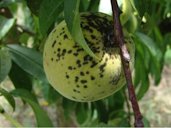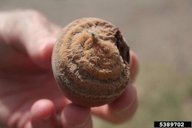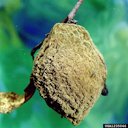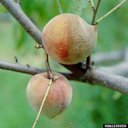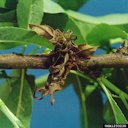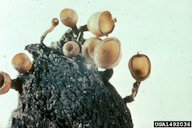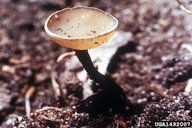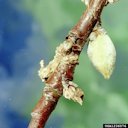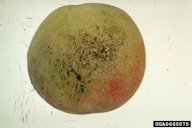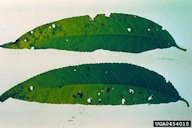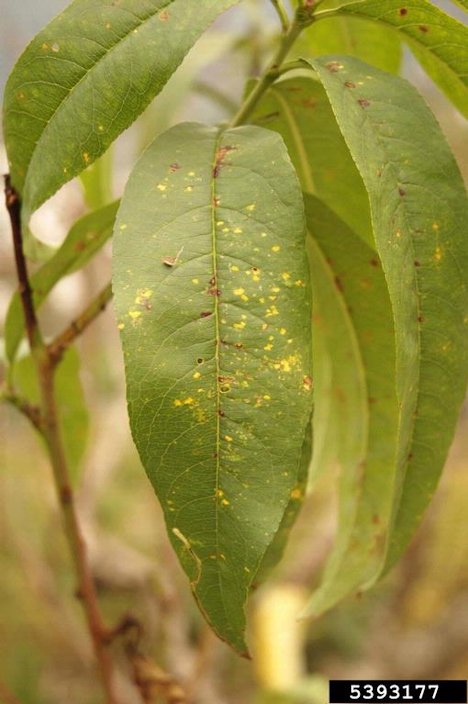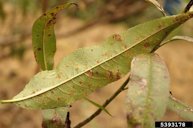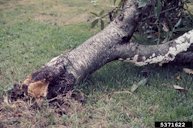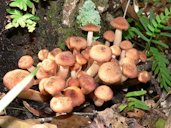| Peach Diseases | ||||||||||||||||||||||||||||||||||||
|---|---|---|---|---|---|---|---|---|---|---|---|---|---|---|---|---|---|---|---|---|---|---|---|---|---|---|---|---|---|---|---|---|---|---|---|---|
| Back
to Peach Page  Fig. 1 Peach scab on ‘UFSun’ fruit, showing lesions around where the pedicel was located 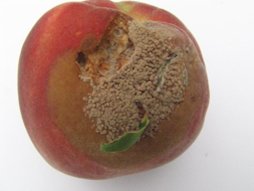 Fig. 4  Brown rot on peach 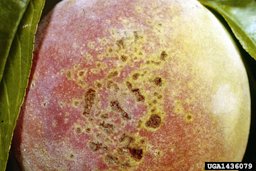 Fig. 12  Bacterial spot Xanthomonas campestris pv. pruni 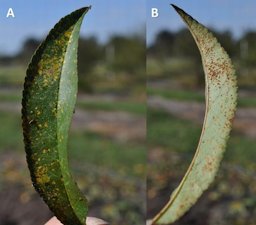 Fig. 16  Peach leaf rust on the top (A) and bottom (B) of a peach leaf; severe infections result in groups of brown spores on the underside of the leaf and can cause tree defoliation 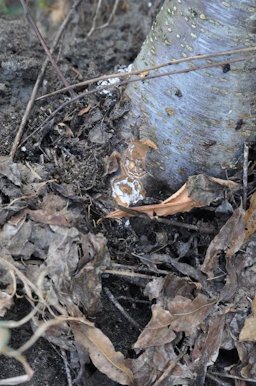 Fig. 19  Mushroom root rot caused by Armillaria spp. in peaches shown with a cut in the bark near the soil line. Notice white hyphae just under the bark before cutting into the wood.  Fig. 23  Homalodisca vitripennis, vector of Phony Peach disease 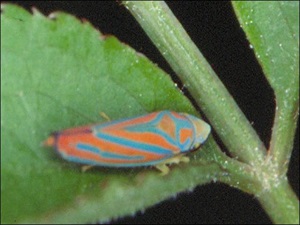 Fig. 24  A leafhopper, Graphocephala sp. that vectors Xylella fastidiosa 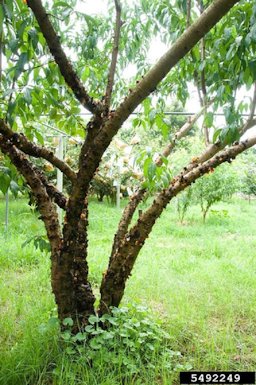 Fig. 25  Gummosis symptom on peach trunk
|
Peach
Scab (Fig. 1) Caused by Cladosporium carpophylium Peach scab affects peaches and nectarines in all areas of the state, causing small brown spots with a green halo on the fruit skin. Chemical or organic fungicide applications are recommended from fruit set through harvest to control peach scab. However, the earliest peach and nectarine cultivars ripen before lesions are very noticeable. 1
Fig. 2. C. carpophilum lesions formed on peach twig Fig. 3. Peach scab lesions on young fruit, showing sunken, dark green, imperfect circles where spores are located Further Reading Peach Scab, University of Florida pdf Brown Rot (Fig. 4) Caused by Monilinia spp. Within the state of Florida, brown rot has historically been most problematic in the Panhandle and northernmost counties, with sporadic problems in central Florida. The likelihood of disease occurring each year and the severity of epidemics that occur generally decrease through the southernmost production areas. In Gainesville, the disease is common on dooryard peaches and plums but may occur after the early commercial harvest; however, when conditions are favorable for disease, losses can be severe. 6
Fig. 5. Brown rot (M. fructicola), honey, sporulation on rotted fruit Fig. 9,10. Fruiting bodies Further Reading Peach Brown Rot, University of Florida pdf Bacterial spot (Fig. 12) Caused by Xanthomonas campestris pv. pruni Bacterial spot can be serious on 'Flordaprince' and 'Tropicbeauty' peaches in some years, and it is difficult to control. Growing peach and nectarine varieties with resistance to bacterial spot is the best control measure, and many of the recently released cultivars have good resistance to bacterial spot. Well-fertilized trees are less susceptible to bacterial spot than underfertilized trees. 1
Fig. 13,14. Bacterial leaf spot on peach, on leaves Fig. 15. Detail of a peach leaf cv. Maria Serena affected with spots Peach Rust (Fig. 16) Caused by Tranzchelia discolor (Fuckel) Peach leaf rust is of the more serious diseases in Central Florida. Severe defoliation can occur by midsummer in some instances and undoubtedly weakens the trees. Early fall defoliation can result in off-season bloom during fall and winter, which reduces yield the following spring. In North Florida, infection usually does not appear until late summer or fall, as it does in Georgia and South Carolina, where the disease is considered to be of minor importance. 1
Further Reading Peach Rust (Transchelia spp.), University of Florida pdf Peach Rust Caused by Tranzschelia discolor in California, University of California pdf Armillaria Root and Crown Rot (Fig. 19) Caused by Armillaria tabescens and A. mellea Armillaria root and crown rot (also known as oak root rot) is a major cause of premature tree death in southeastern stone fruit orchards. In addition, the persistence of the causal agent on root pieces in the soil frequently prevents the establishment of new orchards in previously infested sites. In established orchards, spread of Armillaria root disease can be slowed by tree removal. Complete removal of the tree and its root system is necessary to prevent root-to-root initiated infection of neighboring trees. It is important that the presence of Armillaria is verified by examination of the roots and crown for signs of the fungus. 5
Fig. 21,22. Parasitic and/or saprobic on hardwood roots. Prolific late summer and early fall mushroom popping up in lawns and on forest floors in tight clusters that share a basal anchor to the ground which connects to hardwood roots underground. A. tabescens synonym. Note insect larvae in gills. Xylella Diseases Caused by the Xylella fastidiosa bacterium The bacterium X. fastidiosa is spread primarily by a type of leafhopper known as sharpshooters. The major insect vector in the coastal plain of the southeastern U.S. is probably the glassy-winged sharpshooter, Homalodisca vitripennis (Fig. 23), but other xylem-feeding insects including froghoppers and spittlebugs are considered to be potential vectors. Other leafhopper vectors include H. insolita, Oncometopia spp., Graphocephala spp. (Fig. 24) and Draeculacephala spp. 2 Further Reading Xylella Fastidiosa Diseases and Their Leafhopper Vectors, University of Florida pdf Leafhopper Vectors, University of Florida ext.link Fungal Gummosis (Fig. 25) Caused by Botryosphaeria dothidea The fungus Botryosphaeria dothidea causes the disease peach fungal gummosis (PFG), a vascular disease that limits the growth and yield of peach orchards in the southeastern United States (Reilly and Okie 1982). Additional species of Botryosphaeria, including B. rhodina and B. obtusa, have also been associated with gumming and dieback symptoms on peaches in the United States. 3 The disease gets its name from the large amount of gum oozing from diseased tissue. The disease causes a general decline of infected trees and is often confused with mechanical injury, insect borers, and other tree diseases. The earliest symptom appears on young bark as small spots with oozing resin, generally centered on a lenticel. "Flordadawn', Gulfcrimson and Gulfking' cultivars have a high susceptibility to the disease. 3 Further Reading Fungal Gummosis in Peach, University of Florida pdf Peach Tree Short Life In the southeastern United States, peach tree short life (PTSL) refers to the sudden spring collapse and death of young peach trees. Generally, trees 3 to 7 years old are affected. PTSL is not caused by a single specific factor, but rather by a complex of cold damage and bacterial canker, caused by Pseudomonas syringae pv. syringae, which act together in some years and independently in other years. In any case, the final result is the same (i.e., tree death). 4 Further Reading Natural Enemies and Biological Control, University of Florida pdf Southeastern Peach, Nectarine, and Plum Pest Management and Culture Guide, Georgia University pdf Disease Management, University of Florida ext link |
|||||||||||||||||||||||||||||||||||
| Bibliography 1 Olmstead, Mercy, et al. "Florida Subtropical Peaches: Production Practices." Horticultural Sciences Dept., UF/IFAS Extension, HS1109, Original pub. July 2007, Rev. Aug. 2013, Archived, AskIFAS, edis.ifas.ufl.edu. Accessed 14 Sept. 2014, 10 Apr. 2019. 2 Mizell, Russell F., et al. "Xylella Fastidiosa Diseases and Their Leafhopper Vectors." Entomology and Nematology Dept., UF/IFAS Extension, ENY-683, Original pub. Jan. 2003, Rev. Feb. 2008, Reviewed July 2020, edis.ifas.ufl.edu/in174. Accessed 30 Sept. 2018, 2 Feb. 2023. 3 Mancero-Castillo, et al. "Fungal Gummosis in Peach." Horticultural Sciences Dept., HS1265, Original pub. July 2015, Rev. July 2018, edis.ifas.ufl.edu/hs1265. Accessed 30 Sept. 2018. 4 Beckman, Thomas G., and Andrew P. Nyczepir. "Peach Tree Short Life." USDA-ARS, Tree Fruit Research Laboratory, ent.uga.edu. Accessed 14 Sept. 2014. 5 Cox, Kerik D., et al. "Armillaria Root and Crown Rot." Dept. of Plant Pathology University of Georgia, USDA-ARS Fruit and Tree Nut Research Station, AskIFAS, hos.ifas.ufl.edu/stonefruit/production/disease-management/. Accessed 2 Feb. 2023. 6 "Stone Fruit Disease Management." University of Florida, UF/IFAS, edis.ifas.ufl.edu/topic_stone_fruit_diseases. Accessed 30 Sept. 2018. 7 Sarkhosh, Ali, et al. "Peach Brown Rot." Horticultural Sciences Dept., UF/IFAS Extension, HS1357, Original pub. Feb. 2020, AskIFAS, edis.ifas.ufl.edu/publication/hs1357. Accessed 2 Feb. 2023. Photographs Fig. 1 Olmstead, M. "Peach Scab (Cladosporium carpophilum)." Horticultural Sciences Dept., UF/IFAS Extension, AskIFAS, edis.ifas.ufl.edu/hs1249. Accessed 7 Sept. 2014. Fig. 2 "Cladosporium carpophilum lesions formed on peach twig." Clemson University, USDA Cooperative Extension Slide Series, 2003, Updated 2011, Bugwood.org, (CC BY 3.0 US), www.bugwood.org. Accessed 7 Feb. 2017. Fig. 3 Brannen, Phil. "Peach scab lesions on young fruit, showing sunken, dark green, imperfect circles where spores are located." University of Georgia, edis.ifas.ufl.edu. Accessed 5 Oct. 2014. Fig. 4 England, Gary. "Brown Rot on Peach." UF/IFAS Extension, AskIFAS, edis.ifas.ufl.edu.Accessed 6 Sept. 2014. Fig. 5 Ong, Kevin. "Brown rot (Monilinia fructicola) (G. Wint.) Honey, Sporulation on rotted fruit." Texas AgriLife Extension Service, 2003, Updated 2011, Bugwood.org, (CC BY 3.0 US), www.bugwood.org. Accessed 7 Feb. 2017. Fig. 6,7,8,11 " Symptoms of brown rot Monilinia fructicola." Clemson University, USDA Cooperative Extension Slide Series, 2003, Updated 2011, Bugwood.org, (CC BY 3.0 US), www.bugwood.org. Accessed 7 Feb. 2017. Fig. 9,10 "Brown Rot Monilinia fructicola Fruiting Bodies." University of Georgia Plant Pathology Archive, University of Georgia, 2007, (CC BY 3.0 US), www.bugwood.org. Accessed 10 Sept. 2014. Fig. 12 "Bacterial spot of stone fruits. (Xanthomonas arboricola pv. pruni) (Smith 1903) auterin et al." Clemson University, USDA Cooperative Extension Slide Series, 2002, Updated 2011, Bugwood.org, (CC BY 3.0 US), www.bugwood.org. Accessed 7 Sept. 2014. Fig. 13 Keil, H. L. "Small circular sunken brown lesions on peach fruit due to Xanthomonas campestris pv. pruni." University of Georgia, 2004, Bugwood.org, (CC BY 3.0 US), www.bugwood.org. Accessed 10 Sept. 2014. Fig. 14 Keil, H. L. "Peach (Prunus persica) leaves with lesions and shot holes caused by Xanthomonas campestris pv. pruni." University of Georgia, 2010, Bugwood.org, (CC BY 3.0 US), www.bugwood.org. Accessed 7 Sept. 2014. Fig. 15 Mazzcchi, U. "Detail of a peach leaf cv. Maria Serena affected with spots." Universita di Bologna, 2004, Updated 2011, Bugwood.org, (CC BY 3.0 US), www.bugwood.org. Accessed 7 Sept. 2014. Fig. 16 Olmstead, M. "Peach Leaf Rust." Horticultural Sciences Dept., UF/IFAS Extension, AskIFAS, edis.ifas.ufl.edu. Accessed 7 Sept. 2014. Fig. 17,18 Shen, Yuan-Min. "Yellow colored spot on surface of peach leaves." Taichung District Agricultural Research and Extension Station, 2009, Bugwood.org, (CC BY 3.0 US), www.bugwood.org. Accessed 10 Sept. 2014. Fig. 19 Olmstead, M. "Mushroom root rot caused by Armillaria spp. in peaches shown with a cut in the bark near the soil line. Notice white hyphae just under the bark before cutting into the wood." Horticultural Sciences Dept., UF/IFAS Extension, AskIFAS, edis.ifas.ufl.edu. Accessed 6 Sept. 2014. Fig. 20 "Symptoms of Armillaria root rot, Armillaria tabescens." Florida Division of Plant Industry Archive, Florida Department of Agriculture and Consumer Services, 2008, Bugwood.org, (CC BY 3.0 US), www.bugwood.org. Accessed 10 Sept. 2014. Fig. 20,21 Young, Curtis E. "Symptoms of Armillaria root rot, Armillaria tabescens. Fruiting Bodies." The Ohio State University, 2013, Bugwood.org, (CC BY 3.0 US), www.bugwood.org. Accessed 10 Sept. 2014. Fig. 23 "Homalodisca vitripennis, vector of Phony Peach Disease." Horticultural Sciences Dept., UF/IFAS Extension, AskIFAS, edis.ifas.ufl.edu. Accessed 8 Sept. 2014. Fig. 24 ."A leafhopper, Graphocephala sp., that vectors Xylella fastidiosa." Horticultural Sciences Dept., UF/IFAS Extension, AskIFAS, edis.ifas.ufl.edu. Accessed 8 Sept. 2014. Fig. 25 Shen, Yuan-Min. "Gummosis symptoms on peach trunk." Taichung District Agricultural Research and Extension Station, 2013, Bugwood.org, (CC BY 3.0 US), www.bugwood.org. Accessed 13 Sept. 2014. Published 8 Sept. 2014 LR. Last update 2 Feb. 2023 LR |
||||||||||||||||||||||||||||||||||||

